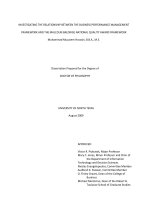Lecture Performance management: Session 3 - Osman Bin Saif
Bạn đang xem bản rút gọn của tài liệu. Xem và tải ngay bản đầy đủ của tài liệu tại đây (2.88 MB, 35 trang )
Session: Three
HRM-755
PERFORMANCE
MANAGEMENT
OSMAN BIN SAIF
1
Summary of Previous Lecture
•
Disadvantages / Dangers of poorly
implemented PM systems
•
Case study
•
Reward Systems
•
Types of Return
•
Aims and Role of PM system
•
Characteristics of Ideal PM system
•
Case Study- PM system
2
Agenda of Today’s Lecture
•
Performance management Process
–
–
Components of Performance Management
process
•
Pre-requisites
•
Performance Planning
Implementation of Performance Management
process
3
Performance management
process
•
“In theory, the Performance Review
process can be thought of a positive
interaction between a coach and an
employee, working together to achieve
maximum performance . In reality, its more
like finding a dead squirrel in your
backyard and realizing the best solution is
to fling it into your neighbors roof”.
--SCOTT ADAMS
4
Performance management
process (Contd.)
•
•
•
Performance management is an ongoing
process.
PM does not take place just once a year, it
is a continuous process including several
components.
These components are closely related to
each other, and poor implementation of
any of the component has a negative
impact on the performance management
5
system as a whole.
•
These are
the
components
of a
Performanc
e
Managemen
t Process.
6
Prerequisites
There are two main prerequisites that are
required before a performance management
system is implemented
•
•
Knowledge of organizations mission and
strategic goals and
Knowledge of job in question
7
Prerequisites (Contd.)
•
PRE-REQUISITE 1
–
Knowledge of organizations mission and
strategic goals is a result of strategic planning
–
Strategic planning allows an organization to
clearly define it purpose or reason for existing,
where it wants to be in future, the goals it
wants to achieve and the strategies it will use
to attain these goals.
8
Prerequisites (Contd.)
–
Once the goals for the entire organization has
been established, similar goals cascade
downward, with departments setting
objectives to support the organizations overall
mission and objectives.
–
The cascading continues downward until each
employee has a set of goals compatible with
those of the organization.
9
Prerequisites (Contd.)
•
PRE-REQUISITE 2
–
The second important pre-requisite before a
performance management system is
implemented is to understand the job in
question.
–
This is done through job analysis.
–
Job analysis is a process of determining the
key components of a particular job, including
activities, tasks, products, services and
processes.
10
Prerequisites (Contd.)
–
A job analysis is a fundamental pre-requisite
of any performance management system.
–
Without a job analysis, it is difficult to
understand what constitutes the required
duties for a particular job.
–
If we don’t know what an employee is
supposed to do on the job, we won’t know
what needs to be evaluated and how to do so.
–
As a result of the job analysis, we obtain
information regarding the tasks carried out
11
and the knowledge, skills and abilities (KSAs)
Prerequisites (Contd.)
KSA refers to;
•
K- (knowledge)
–
•
S- (skills)
–
•
Information needed to perform the work
Required attributes that are usually acquired
by having done the work in the past
A- (ability)
–
The physical, emotional, intellectual and
12
psychological aptitude to perform work.
Prerequisites (Contd.)
•
•
The tasks and KSAs needed for the
various jobs are typically presented in the
form of job description, which summarizes
the job duties, needed KSAs and working
conditions for a particular job.
CASE- Example– Trailer Truck Driver Job
Description.
13
14
Prerequisites (Contd.)
•
This job description includes information
about;
–
What tasks are to be performed (e.g operation
of a specific type of truck)
–
Information about the needed
•
•
•
knowledge (e.g manifests, bill of lading)
Skills (e.g keeping truck and trailer under control,
particularly in difficult whether conditions)
Abilities (e.g physical and spatial abilities needed
to turn narrow corners)
15
Prerequisites (Contd.)
•
Job Analysis:
–
Job analysis can be conducted using
observation, off-the-shelf questionnaires or
interviews.
–
Alternatively if the job is yet to be created,
data can be gathered from individuals
responsible for creating the job or those who
will supervise the individuals in the new
position.
16
17
18
Performance planning
•
Employees should have thorough
knowledge of the performance
management system. In fact, at beginning
of each performance cycle the supervisor
and the employee meet to discuss, and
agree upon, what needs to be done and
how it should be done.
19
20
Performance planning (Contd.)
•
The performance planning includes;
–
–
–
a consideration of both results
and behaviors,
as well as a developmental plan.
21
Results
•
•
Results refer to what need to be done or
the outcomes an employee must produce.
A consideration of results needs to include
the key accountabilities, or broad areas of
a job for which the employee is
responsible for producing results.
22
Results (Contd.)
•
•
•
This information is typically obtained from
the job discussion.
A discussion of results also includes
specific objectives that the employee will
achieve as a part of each accountability.
Objectives are statements of important
and measurable outcomes.
23
Results (Contd.)
•
•
•
Finally, discussing results also means
discussing performance standards.
A performance standard is a yardstick
used to evaluate how well employees
have achieved each objective.
Performance standards provide
information about acceptable and
unacceptable performance.
24
Results (Contd.)
•
Example:–
Consider the job of a university professors.
–
Two key accountabilities are;
–
•
Teaching
•
Research
An objective for teaching could be “to obtain a
student evaluation of teaching performance
on a point scale.
25









